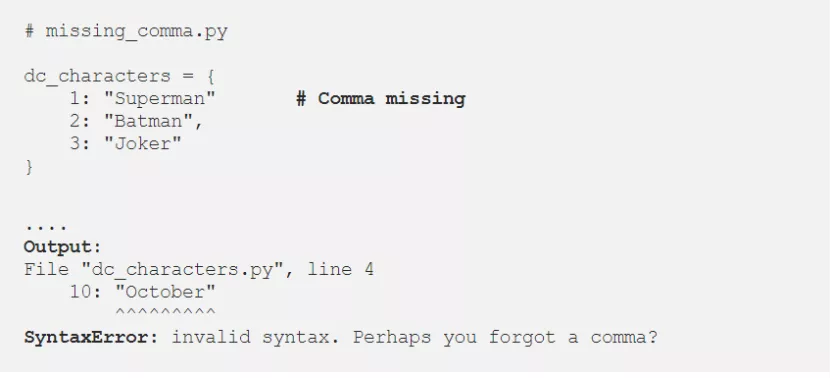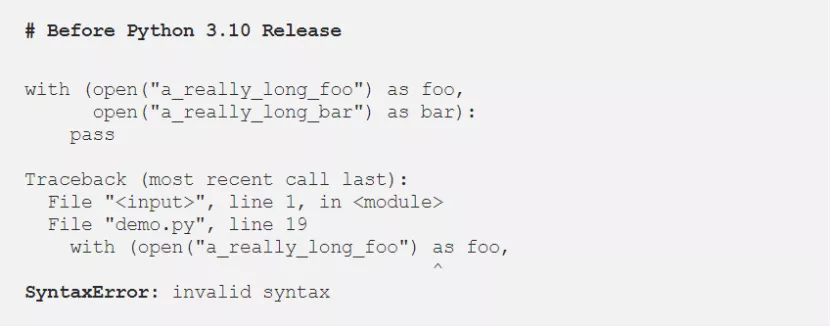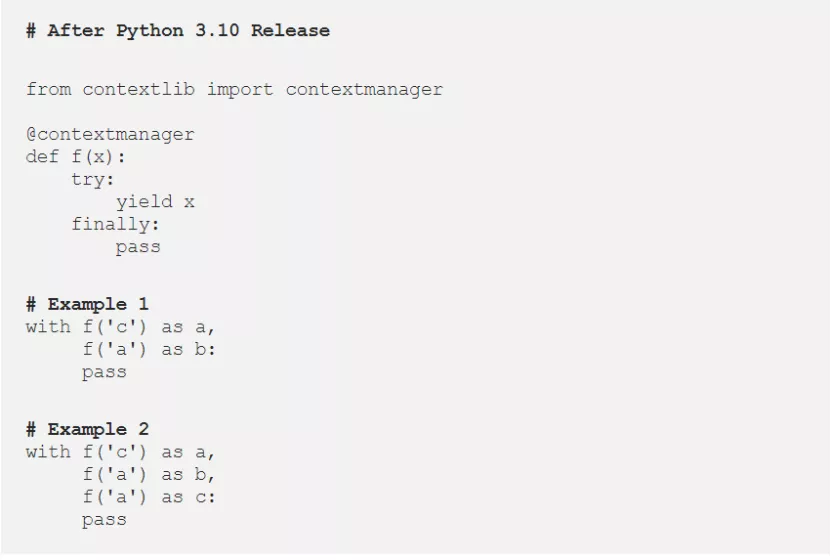 Backend Development
Backend Development
 Python Tutorial
Python Tutorial
 Python 3.10 is released! You should know these 5 new features
Python 3.10 is released! You should know these 5 new features
Python 3.10 is released! You should know these 5 new features
Python has been in the market for a while now, and as a Python developer, I am happy to share that Python is gradually getting updates and improvements with each new version. The latest version of Python, 3.10, has some major improvements, and I'll list those updates here. I've listed the first 5 updates for this new version.
1. Improvements in error messages
For Python developers, when you write code and encounter an error, error messages can help you find the error in the code. Improved error messages make your life easier than when using previous Python versions. For example, consider the following code, where there are no brackets at the end of the second line:

# In previous versions - Python 3.9 and earlier, you would see the following Error -

Well, invalid syntax! Now, as a developer, what do you understand from this error message? Well, personally, I don't understand anything except the fact that somewhere on line 3 I added wrong syntax.
But, does the error really appear on line 3? Python 3.10 is the savior in this case, with the latest updates. For the same piece of code, Python 3.10 will throw the following error message -

The line number and very specific error message will allow you to jump right in, fix the error, and continue coding! Another example of my personal attempt to see if the error message is clear enough -

This is really a cool update in the Python 3.10 version, please leave a comment on this article Share your thoughts on this section.
2. Simpler type union syntax
In past Python versions, more tools have moved from type conversion to built-in functions to avoid importing static types every time. Now look at this change -

In Python 3.10, you are now allowed to use the pipe operator (|) to specify type unions instead of from the input module Import union. In addition, the existing typing.Union and | syntax should be equivalent, as compared with the following -

3. Use multiple `with` statements in multiple lines
Python does support multi-line statements through the use of backslash(), but some constructs in Python do not require the use of slashes to write multi-line statements. One of them is a context manager with a multi-line with() statement. For example -

Yes, this may not seem like a feature, but it is a significant improvement over previous versions as you may have encountered using multi-line context managers use case, but failed to execute due to the above error. If you're still confused, let's give some more examples of what you can do with the Python 3.10 version of the context manager -

You can now have multi-line contexts manager statement without using backslashes. Great, right?
4. Better type aliases
Type aliases allow you to quickly define new aliases that can be created for complex type declarations. For example -

This usually works fine. However, it is usually impossible for a type checker to know whether such a statement is a type alias or just a definition of a regular global variable.

The above python code declares an alias UserInfo for tuple[str, str] because it is a data type that combines values of multiple types. In our case it's a string and an integer. Additionally, adding TypeAlias annotations clarifies intent to the type checker and anyone reading your code.
5. Stricter sequence compression
zip() is a built-in function in Python that you may have used when combining multiple lists/sequences. Python 3.10 introduces the new strict parameter, which adds a runtime test to check that all compressed sequences have the same length. For example -

zip() can be used to iterate these three lists in parallel:

Let’s use the above again The names and numbers of the two sequences are displayed. Now the only difference is that the numbers between these sequences are different lengths of the sequence names as shown below -

Note that all the information about the name - Kevin Gone! If your data set is larger, it will be harder to find such errors. Even if you find a problem, diagnosing and fixing it isn't always easy. The assumption that the compressed sequences will be of the same length not only helps you avoid this discrepancy. In Python 3.10, the strict parameter can help you avoid this situation in the first place -

While strict doesn't really add any new functionality to zip(), It helps you avoid those hard-to-find mistakes.
Other updates in Python 3.10 This version has a lot of bug fixes as well as some other small updates, which can be found on the official release page if you are interested.
Original text: https://varun-singh-01.medium.com/python-3-10-released-top-5-new-features-you-should-know-bf968ac99230
The above is the detailed content of Python 3.10 is released! You should know these 5 new features. For more information, please follow other related articles on the PHP Chinese website!

Hot AI Tools

Undresser.AI Undress
AI-powered app for creating realistic nude photos

AI Clothes Remover
Online AI tool for removing clothes from photos.

Undress AI Tool
Undress images for free

Clothoff.io
AI clothes remover

Video Face Swap
Swap faces in any video effortlessly with our completely free AI face swap tool!

Hot Article

Hot Tools

Notepad++7.3.1
Easy-to-use and free code editor

SublimeText3 Chinese version
Chinese version, very easy to use

Zend Studio 13.0.1
Powerful PHP integrated development environment

Dreamweaver CS6
Visual web development tools

SublimeText3 Mac version
God-level code editing software (SublimeText3)

Hot Topics
 1655
1655
 14
14
 1414
1414
 52
52
 1307
1307
 25
25
 1253
1253
 29
29
 1228
1228
 24
24
 PHP and Python: Different Paradigms Explained
Apr 18, 2025 am 12:26 AM
PHP and Python: Different Paradigms Explained
Apr 18, 2025 am 12:26 AM
PHP is mainly procedural programming, but also supports object-oriented programming (OOP); Python supports a variety of paradigms, including OOP, functional and procedural programming. PHP is suitable for web development, and Python is suitable for a variety of applications such as data analysis and machine learning.
 Choosing Between PHP and Python: A Guide
Apr 18, 2025 am 12:24 AM
Choosing Between PHP and Python: A Guide
Apr 18, 2025 am 12:24 AM
PHP is suitable for web development and rapid prototyping, and Python is suitable for data science and machine learning. 1.PHP is used for dynamic web development, with simple syntax and suitable for rapid development. 2. Python has concise syntax, is suitable for multiple fields, and has a strong library ecosystem.
 PHP and Python: A Deep Dive into Their History
Apr 18, 2025 am 12:25 AM
PHP and Python: A Deep Dive into Their History
Apr 18, 2025 am 12:25 AM
PHP originated in 1994 and was developed by RasmusLerdorf. It was originally used to track website visitors and gradually evolved into a server-side scripting language and was widely used in web development. Python was developed by Guidovan Rossum in the late 1980s and was first released in 1991. It emphasizes code readability and simplicity, and is suitable for scientific computing, data analysis and other fields.
 Python vs. JavaScript: The Learning Curve and Ease of Use
Apr 16, 2025 am 12:12 AM
Python vs. JavaScript: The Learning Curve and Ease of Use
Apr 16, 2025 am 12:12 AM
Python is more suitable for beginners, with a smooth learning curve and concise syntax; JavaScript is suitable for front-end development, with a steep learning curve and flexible syntax. 1. Python syntax is intuitive and suitable for data science and back-end development. 2. JavaScript is flexible and widely used in front-end and server-side programming.
 How to run sublime code python
Apr 16, 2025 am 08:48 AM
How to run sublime code python
Apr 16, 2025 am 08:48 AM
To run Python code in Sublime Text, you need to install the Python plug-in first, then create a .py file and write the code, and finally press Ctrl B to run the code, and the output will be displayed in the console.
 Can vs code run in Windows 8
Apr 15, 2025 pm 07:24 PM
Can vs code run in Windows 8
Apr 15, 2025 pm 07:24 PM
VS Code can run on Windows 8, but the experience may not be great. First make sure the system has been updated to the latest patch, then download the VS Code installation package that matches the system architecture and install it as prompted. After installation, be aware that some extensions may be incompatible with Windows 8 and need to look for alternative extensions or use newer Windows systems in a virtual machine. Install the necessary extensions to check whether they work properly. Although VS Code is feasible on Windows 8, it is recommended to upgrade to a newer Windows system for a better development experience and security.
 Where to write code in vscode
Apr 15, 2025 pm 09:54 PM
Where to write code in vscode
Apr 15, 2025 pm 09:54 PM
Writing code in Visual Studio Code (VSCode) is simple and easy to use. Just install VSCode, create a project, select a language, create a file, write code, save and run it. The advantages of VSCode include cross-platform, free and open source, powerful features, rich extensions, and lightweight and fast.
 How to run python with notepad
Apr 16, 2025 pm 07:33 PM
How to run python with notepad
Apr 16, 2025 pm 07:33 PM
Running Python code in Notepad requires the Python executable and NppExec plug-in to be installed. After installing Python and adding PATH to it, configure the command "python" and the parameter "{CURRENT_DIRECTORY}{FILE_NAME}" in the NppExec plug-in to run Python code in Notepad through the shortcut key "F6".



